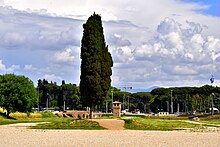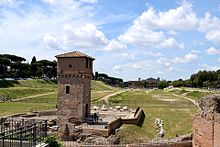Circus Maximus

The Circus Maximus ( Italian Circo Massimo ) was the largest circus in ancient Rome . It had a total length of 600 meters (including the arena and steps) and a width of 140 meters. According to Dionysius of Halicarnassus, its capacity should have been 150,000 places at the time of Augustus and 250,000 at the time of the older Pliny . It was used for chariot races until the 6th century .
The construction history of the Circus Maximus
Already in the 6th century BC The swampy Murcia valley between Palatine and Aventine was drained and could then be used for various competitions. According to legend, King Lucius Tarquinius Priscus is said to have erected the first wooden stands, which in the further history of the circus collapsed again and again, sometimes resulting in many deaths.
It was not until Gaius Iulius Caesar , who expanded the width of the circus, that on the occasion of his triumphal games in 46 BC. Some permanent marble seating steps were built in BC and surrounded the arena with a moat to separate it from the auditorium. After a fire in 31 BC In BC Augustus renewed the circus, expanded it further, built a first imperial lodge and in 10 BC it opened. BC the first obelisk in the middle of the Spina, the then probably still wooden partition between the tracks. The obelisk stands today in the Piazza del Popolo in Rome. The second obelisk , found today in front of the Lateran , was added by Constantius II in 357. In the imperial era, the circus served not least for communication between the rulers and the townspeople, whose acclamations were received here.
Domitian had the imperial palace on the Palatine extended so that he could watch the games directly from there and show himself to the people from an imperial box connected to the palace. But it was not until the year 103 under Trajan that the circus was completely built with stone, opus caementitium and bricks. He had Domitian's imperial box torn down and added an imperial box to the circus itself. In the early 4th century AD, the circus then reached its maximum level of expansion.
A mosaic that was important for the reconstruction of the building at that time was discovered in the “House of Mosaics” in the town of Luna, famous for its Carrara marble, on the Ligurian coast. The 3rd / 4th Floor decorations laid in the 15th century AD show the circus very precisely and, together with other finds not from Luna, enable a reconstruction of the famous racecourse with the imperial box.
The circus as a venue for chariot races
The Roman Circi had an elongated shape with a straight end at the starter boxes and a rounded end on the opposite side. The spina , which was decorated with two Egyptian obelisks, divided the path along the longitudinal axis. The teams circled the Spina counterclockwise, usually seven times. On the spina in the Circus Maximus was a frame with seven lowerable wooden eggs, which was later replaced by one with seven marble dolphins. The drivers and spectators could see how many laps had been covered from the number of eggs or dolphins that had been lowered.
The chariot races ( ludi circenses ) in the Circus Maximus were public events that were held as part of celebrations and mostly at state expense. At the time of the Roman Republic, a full-day program consisted of 12 races. During the imperial era, this number was increased to 24. On these occasions, images of the gods in silver and ivory carriages, which were kept in the aedes Tensarum on the Capitol , were brought in procession to the circus.
The first races in the Circus Maximus took place, as the provisions on victory prices in the Twelve Tables Act show, probably no later than the middle of the 5th century BC The last ones did not testify until the end of late antiquity - under the rule of the Ostrogoth king Totila in 549 or 550 AD.
There were other smaller Circi in Rome, such as the Circus Flaminius on the Marsfeld , the Circus des Nero in the area of today's Vatican , the Circus Varianus on the Via Labicana and the Circus des Maxentius on the Via Appia .
Circi and hippodromes were also laid out in the provinces in order to offer the Romans and veterans living there the same entertainment options as in Rome. In addition, chariot races in imperial residences and governor's seats played an important role in political communication, see also Circus (antiquity) .
Other ancient uses
In addition to the chariot races of the "Circus Games", gladiator fights and animal baiting took place in the Circus Maximus .
From 186 BC In addition, "Greek style games", ie athletic competitions, were held in the Circus Maximus. However, Caesar had their own stadium built for them on the Marsfeld , which later became Domitian's stadium .
Religious buildings were also integrated into the Circus Maximus. On the side facing the Aventine was the temple of the sun god . According to Tertullian, there was an underground altar for Consus under the first so-called Murcian turning mark .
In the Western substructures a received today was Mithraeum installed.
Re-use and excavations

From the later 6th century the Circus Maximus disintegrated. The large open area was then partly used for agriculture in the Middle Ages. The church of Santa Lucia in Settizodio with numerous outbuildings was built in the eastern part. Another part was used by the Frangipane family as a fortress. In the end, most of the marble seating steps were dismantled so that they could be reused in the construction of St. In the 19th century a gasometer was built in the western part . The remaining area was built over mainly with small businesses. In the 1930s, the area began to be exposed again.
The Circus Maximus is now a lawn in which the old shape is still recognizable. On the eastern curve, behind which the Via Appia begins, there have been excavations since 1936. Parts of the ancient rows of seats and stairs as well as the remains of a tower of the complex of Santa Lucia in Settizodio were uncovered.
The facility is used for large events and a mass audience. According to the organizers, Live 8's Italian concert took place here on July 2, 2005 in front of around 200,000 visitors. The Italian national soccer team was also received in Circus Maximus on July 10, 2006 after winning the World Cup . On July 14, 2007, the British rock band Genesis played in front of over 500,000 fans in the Circus Maximus, according to the Italian press.
From 2008 to 2016, excavations were made in the foundations of the grandstands on the southern edge of the facility. In this way, water basins for horses could be exposed, as well as food stands, latrines and several chambers that belonged to a brothel. Unexpectedly, the substructure of a triumphal arch from the time of Titus was discovered in 2014 and 2015 , which, like its counterpart on the Via Sacra in the Roman Forum, celebrated the victory over the Jews in AD 70. According to archaeologists, this second, three-sided Arch of Titus remained intact until the 8th century. In the Middle Ages, the middle of the three vaults, which was still preserved at that time, was integrated into the new construction of an aqueduct. However, this triumphal arch at the Circus Maximus was not unknown as it is historically attested. The Renaissance poet Fazio degli Uberti (around 1309 − around 1367) already called the arch Arco di Prisco because of its location and reports on the tradition of triumphal arches that would have stood at the Circus Maximus and their crowning of horses during the reign of the Emperor Constantine had been brought to Constantinople. A little later, the humanist scholar Poggio Bracciolini (1380–1459) wrote that the age of the bow had left little visible.
At the end of 2016, an exhibition opened in the grandstands, giving access to the components.
literature
- Filippo Coarelli : Rome. An archaeological guide. Verlag von Zabern, Mainz 2000, ISBN 3-8053-2685-8 , pp. 315-318.
- Frank Kolb : Rome, the history of the city in antiquity . CH Beck, Munich 1995, ISBN 3-406-39666-6 .
- Heinz-Joachim Fischer : Rome. Two and a half millennia of history, art and culture of the Eternal City . DuMont Buchverlag, Cologne 2001, ISBN 3-7701-5607-2 , p. 183.
- Anton Henze : Art Guide Rome . Reclam, Stuttgart 1994, ISBN 3-15-010402-5 , p. 91.
- Karl-Wilhelm Weeber : Panem et circenses. Mass entertainment as politics in ancient Rome (special volume Ancient World). Verlag Philipp von Zabern, Mainz 1994, ISBN 3-8053-1580-5 , pp. 40-69.
- Karl-Wilhelm Weeber: Circus Maximus: chariot races in ancient Rome . Primus Verlag, Darmstadt 2010, ISBN 3-89678-807-8 .
Web links
Remarks
- ↑ “At that time, the space was marked out for the first time for the circus, which is now called Circus Maximus. The senators and the knights were assigned separate places where each of them could set up spectator seats; they were called fori (rows of seats); they watched from the seats, which rested on two-pronged posts and were twelve feet above the ground. The performance consisted of horse races and fistfights, the actors of which had been brought in mainly from Etruria. The solemn games then became an annual institution and were called either ludi Romani (Roman games) or ludi magni (great games). ”Liv. 1.35.8-9. Translated by Hans Jürgen Hillen, Düsseldorf and Zurich, 1987.
Individual evidence
- ↑ Sovraintendenza di Roma, Rome Monuments Office
- ↑ Dionysius of Halicarnassus 3, 68.
- ↑ Pliny, Naturalis historia 36, 102; it was proposed to correct the ad sedem CCL of the manuscript to ad sedem p (edum) CL , cf. Erwin Pollack : Circus. In: Paulys Realencyclopadie der classischen Antiquity Science (RE). Volume III, 2, Stuttgart 1899, Col. 2571-2585 (here: Col. 2579). The regional catalog from the 4th century gives a number of 385,000 in connection with the Circus Maximus, although it is unclear whether it relates to the audience or another size.
- ^ Frank Kolb: Rome: The history of the city in antiquity. CH Beck, Munich 2002, ISBN 3-406-46988-4 , p. 603; Jutta Ronke: Magistrate representation in the Roman relief. BAR international series, Oxford 1987, ISBN 0-86054-478-8 , p. 559.
- ^ Tertullian, de spectaculis 5, 7 and 8, 6.
- ↑ Shops, latrines and a brothel. In: Deutschlandfunk , November 18, 2016
- ↑ Second Arch of Titus discovered in Rome. Deutsche Welle, May 29, 2015; Rome opens new Circus Maximus. In: Frankfurter Neue Presse , November 16, 2016
- ↑ Ursula Rombach : Object referentiality and imagination. Notes on the “Dittamondo” of the Fazio degli Uberti . In: Horst Bredekamp , Arnold Nesselrath (Ed.): Pegasus. Berlin contributions to the afterlife of antiquity 10, Census of Antique Works of Art and Architecture Known in the Renaissance, Berlin 2008, ISBN 978-3-86732-050-4 , pp. 21–35; here: p. 34.
Coordinates: 41 ° 53 ′ 10 ″ N , 12 ° 29 ′ 9 ″ E



